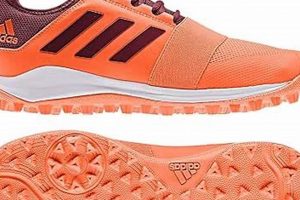The playing surface significantly impacts the speed, consistency, and safety of field hockey. These surfaces, often synthetic, are engineered to provide a predictable ball roll and consistent footing for athletes. The design and composition of these surfaces directly influence gameplay dynamics and player performance, offering a stark contrast to natural grass fields.
The evolution of these specialized fields has been crucial for the sport’s development. Synthetic surfaces allow for play regardless of weather conditions, extending the playing season and ensuring consistent training opportunities. The enhanced grip and evenness reduce the risk of injuries, promoting a safer environment for players. Historically, these surfaces have enabled the sport to reach new levels of speed and precision, attracting a wider audience and fostering competitive growth.
The following sections will delve into the specific types available, the installation process, maintenance requirements, and the environmental considerations associated with these specialized sporting surfaces.
Optimizing Performance on Synthetic Hockey Fields
Achieving peak performance and ensuring longevity of play requires a focused approach. The following tips provide guidance for maximizing benefits and minimizing potential issues related to hockey field usage.
Tip 1: Selection Considerations: When choosing a synthetic surface, carefully evaluate fiber density, pile height, and infill material. Higher fiber density generally offers better ball roll and durability. Proper selection is a long-term investment.
Tip 2: Routine Inspection: Conduct regular inspections for wear and tear, including seam integrity, fiber breakdown, and infill compaction. Addressing minor issues promptly prevents larger, more costly repairs.
Tip 3: Infill Management: Maintain proper infill levels by periodically replenishing materials lost due to play and environmental factors. Infill level affects ball speed, footing, and shock absorption.
Tip 4: Appropriate Footwear: Players should wear footwear specifically designed for use on artificial surfaces. Correct footwear optimizes grip, reduces the risk of injury, and minimizes wear on the turf fibers.
Tip 5: Controlled Irrigation: Implement a controlled irrigation system to manage surface temperature and reduce friction. Proper irrigation also helps settle dust and debris, improving playing conditions.
Tip 6: Specialized Cleaning: Utilize specialized cleaning equipment and techniques to remove debris, prevent algae growth, and maintain the hygienic quality of the playing surface. Regular cleaning extends the life of the investment and enhances player safety.
These considerations provide a foundation for efficient usage, preservation of surface quality, and promotion of optimal playing conditions. Adhering to these guidelines contributes to a safer, more enjoyable, and ultimately more productive sporting environment.
The article will now proceed to detail the maintenance protocols that can effectively extend the lifespan of the hockey field while ensuring player safety.
1. Fiber Composition
The fiber composition of surfaces fundamentally dictates performance characteristics, longevity, and safety aspects within field hockey. The type of fiber used significantly impacts ball behavior, player traction, and overall field resilience.
- Material Type
Fiber materials in these turfs commonly include polyethylene, polypropylene, or a combination thereof. Polyethylene offers enhanced softness and reduced abrasion, beneficial for player comfort and minimizing skin abrasions upon contact. Polypropylene provides increased durability and resistance to wear, crucial for fields subjected to intense, frequent usage. The selection of material directly correlates to the field’s lifespan and player safety.
- Fiber Shape
Fiber shape, such as monofilament or fibrillated, affects ball roll and surface stability. Monofilament fibers, single strands, generally offer a smoother, faster ball roll due to their uniform surface. Fibrillated fibers, which split into multiple smaller strands at the top, provide increased grip and reduce ball bounce, allowing for enhanced control. The choice depends on the desired playing characteristics and style of hockey favored.
- Fiber Density
Fiber density, the number of fibers per unit area, impacts the surface’s resilience and wear resistance. Higher fiber density results in a denser, more robust surface capable of withstanding heavy foot traffic and frequent play. This increased density also contributes to a more consistent ball roll and reduced infill displacement, enhancing the overall playing experience.
- Fiber Height
Fiber height influences ball speed and the amount of infill required. Shorter fibers typically result in faster ball speeds, while longer fibers can provide more cushioning and require a greater volume of infill for stability. Careful consideration of fiber height is essential to achieve the optimal balance between speed, control, and safety.
In conclusion, the properties of fibers profoundly influence the playing characteristics and lifespan of artificial surfaces. Strategic selection based on playing style, usage intensity, and safety requirements optimizes the hockey experience and maximizes the investment in the surface.
2. Infill Density
Infill density, measured as the weight of infill material per unit area of the surface, critically influences the performance characteristics of field hockey surfaces. The infill, typically composed of sand, crumb rubber, or a combination thereof, supports the synthetic fibers and dictates energy absorption, ball roll speed, and player traction. Insufficient infill density leads to instability of the fibers, resulting in inconsistent ball bounce and increased risk of player injury due to inadequate cushioning. Conversely, excessive infill density can create a hard, unforgiving surface, reducing ball speed and potentially exacerbating impact-related injuries.
A practical example highlighting the importance of infill density can be observed in comparing two hypothetical fields. Field A, maintained with optimal infill density, provides a consistent and predictable playing surface. Ball roll is smooth, and players experience secure footing. Field B, with significantly reduced infill due to inadequate maintenance, exhibits uneven ball bounce and increased instances of players slipping during gameplay. This disparity directly affects player performance and increases the likelihood of injuries. Similarly, the type of infill material itself plays a critical role; high-quality, specifically sized materials allow for even distribution and minimize compaction over time, leading to a more consistent playing surface for longer periods.
Maintaining proper infill density is, therefore, essential for optimizing field hockey performance and minimizing the risk of injury. Regular monitoring and replenishment of infill are critical components of comprehensive maintenance protocols. Furthermore, understanding the specific infill requirements of the chosen artificial surface, and adhering to manufacturer guidelines, ensures the field meets prescribed safety standards and provides an optimal playing environment. Failing to address infill density deficiencies can compromise surface integrity and lead to costly repairs or even field replacement.
3. Drainage Systems
Effective drainage systems are a critical, yet often unseen, component of well-performing field hockey surfaces. The synthetic surface itself is largely impermeable, necessitating a carefully engineered drainage infrastructure to manage water accumulation. Inadequate drainage directly impacts gameplay by creating surface water, which reduces ball speed, alters ball trajectory, and increases the risk of player injury. Standing water can create slippery conditions, compromising player footing and increasing the potential for falls. Furthermore, prolonged exposure to moisture promotes the growth of algae and mold, degrading the surface integrity and requiring more frequent and intensive maintenance.
A well-designed drainage system effectively channels water away from the playing surface. This is typically achieved through a combination of subsurface drainage pipes and a precisely graded base layer that directs water flow towards these collection points. The permeability of the base layer is crucial, allowing water to percolate through the synthetic surface and into the drainage network below. In practical terms, consider two comparable hockey surfaces: one with a functioning drainage system and one without. During periods of rainfall, the field with effective drainage remains playable within a short timeframe, maintaining consistent ball roll and player safety. Conversely, the poorly drained field may be rendered unusable for extended periods, disrupting training schedules and potentially causing game cancellations. Moreover, the cost associated with maintaining a waterlogged field, including mold remediation and surface repairs, far exceeds the investment in a robust drainage system.
In conclusion, the relationship between drainage systems and playing surfaces is inseparable. These systems are not merely ancillary components but integral elements of a high-quality, safe, and durable playing environment. Investment in and proper maintenance of subsurface drainage systems is essential to optimize gameplay, reduce injury risk, and ensure the long-term viability of the field hockey surface.
4. Surface Friction
Surface friction plays a pivotal role in field hockey, directly affecting ball speed, player agility, and overall gameplay dynamics. Synthetic field surfaces are engineered to provide a specific coefficient of friction, a balance between grip and glide, that optimizes performance. Too little friction and the ball skids uncontrollably, hindering accurate passing and shooting. Excessive friction slows the ball, impeding fast-paced play and increasing player exertion. The selection of fiber type, infill material, and surface maintenance practices all contribute to controlling the friction characteristics of the playing field.
A practical example illustrates the effect of surface friction. A newly installed surface, properly maintained, exhibits consistent friction, allowing for predictable ball behavior and enhanced player control. Players can execute precise passes and maintain stable footing during quick turns and sprints. In contrast, a surface with degraded fibers and compacted infill experiences reduced friction. Balls may skid unpredictably, passes become inaccurate, and players risk losing their footing, particularly during changes in direction. This degradation significantly impacts the quality of gameplay and increases the likelihood of injuries. Regular brushing and infill redistribution are key maintenance practices to counteract friction loss.
In conclusion, the optimization of surface friction is crucial for creating a safe and competitive field hockey environment. Achieving and maintaining the appropriate friction level requires careful selection of surface materials, diligent maintenance practices, and a thorough understanding of the interplay between these factors. Addressing friction-related issues proactively ensures optimal ball control, minimizes the risk of injury, and maximizes the overall playing experience.
5. Shock Absorption
Shock absorption is a critical performance characteristic of field hockey surfaces. It dictates the degree to which the playing surface can attenuate the impact forces generated during player movements, significantly influencing athlete safety and fatigue levels. An inadequate capacity for dissipating impact energy can lead to increased risk of lower extremity injuries and accelerated player fatigue.
- Material Composition and Layering
The material composition and layering of synthetic hockey surfaces directly influence shock absorption properties. The inclusion of elastic layers, often composed of specialized rubber or foam materials, beneath the primary playing surface enhances energy dissipation. The thickness and density of these layers determine the degree of impact attenuation. For example, a surface incorporating a thicker, higher-density elastic layer will provide greater shock absorption compared to a surface with a thinner or less dense layer. This translates to reduced stress on players’ joints and muscles during high-impact activities such as running and jumping.
- Infill Type and Depth
The type and depth of infill material within the synthetic fibers also contribute to shock absorption. Crumb rubber infill, derived from recycled tires, is frequently used due to its inherent cushioning properties. The depth of the infill layer directly correlates with the level of impact attenuation. A properly maintained infill layer of adequate depth effectively absorbs impact energy, reducing the risk of injuries. Conversely, compacted or depleted infill diminishes shock absorption capacity, increasing stress on athletes’ lower limbs. Regular monitoring and replenishment of infill are essential to maintain optimal shock absorption characteristics.
- Surface Hardness
Surface hardness, measured using standardized testing methods, provides a quantifiable measure of shock absorption capability. Lower surface hardness values indicate greater shock absorption. Field hockey surfaces designed for optimal performance typically exhibit a surface hardness within a specified range, balancing shock absorption with ball roll characteristics. Surfaces that are too hard offer insufficient shock absorption, increasing injury risk. Conversely, excessively soft surfaces can impede ball speed and player agility. Periodic testing of surface hardness is recommended to ensure the surface remains within acceptable parameters.
- Impact Attenuation Testing
Standardized impact attenuation testing protocols, such as those established by industry organizations, provide a means of evaluating the shock absorption performance of surfaces. These tests involve dropping a calibrated weight onto the surface and measuring the resulting impact force. The data obtained from these tests allows for comparison of different surfaces and assessment of compliance with safety standards. Regular impact attenuation testing is essential to verify the shock absorption characteristics and ensure the playing surface meets prescribed performance criteria.
In summary, shock absorption is a multi-faceted characteristic of surfaces directly linked to player safety and performance. The interplay between material composition, infill properties, surface hardness, and adherence to testing protocols dictates the capacity for energy dissipation, significantly influencing the risk of injury and the long-term well-being of athletes.
Frequently Asked Questions
This section addresses common inquiries regarding surfaces utilized in the sport, aiming to provide clear and concise information about their properties, maintenance, and impact on gameplay.
Question 1: What are the primary materials utilized in the construction of specialized surfaces?
The surfaces primarily consist of synthetic fibers, commonly polyethylene or polypropylene, supported by an infill material such as sand or crumb rubber. A base layer, designed for drainage and stability, underlies the synthetic surface.
Question 2: How does the selection of a playing surface impact game speed and ball control?
The density and type of synthetic fibers, along with infill characteristics, influence ball roll speed and player traction. A denser surface generally facilitates faster ball movement, while a properly maintained infill provides enhanced grip for players.
Question 3: What are the routine maintenance requirements for specialized surfaces?
Regular maintenance includes brushing to redistribute infill, removing debris, and addressing algae or mold growth. Periodic inspection for wear and tear, seam integrity, and drainage functionality is essential.
Question 4: How do environmental factors affect the longevity of specialized surfaces?
Exposure to ultraviolet radiation, extreme temperatures, and prolonged moisture can degrade the synthetic fibers and infill. Implementing appropriate maintenance practices, such as irrigation and cleaning, helps mitigate these effects.
Question 5: What are the safety considerations associated with specialized surfaces?
Proper shock absorption is critical for minimizing the risk of lower extremity injuries. Ensuring adequate infill depth and regularly testing surface hardness contribute to a safer playing environment.
Question 6: How do specialized surfaces compare to natural grass in terms of performance and maintenance?
Synthetic surfaces offer greater consistency in ball roll and player traction, require less maintenance, and allow for play in various weather conditions compared to natural grass. However, they require specialized cleaning and may have different impact absorption characteristics.
In summary, understanding the material composition, maintenance requirements, and performance characteristics of specialized surfaces is paramount for optimizing gameplay and ensuring athlete safety.
The following section will elaborate on the environmental considerations associated with specialized hockey turfs.
Conclusion
This exploration has detailed critical elements concerning field hockey turfs. The composition, drainage, friction, and shock absorption of these surfaces significantly affect the performance, safety, and longevity of play. Proper material selection, diligent maintenance, and regular inspection are essential to optimizing the playing environment and minimizing the risk of injury.
The future of field hockey hinges, in part, on continued advancements in surface technology and sustainable practices. A commitment to responsible field management and ongoing research into innovative materials will ensure that these specialized surfaces remain a cornerstone of the sport, fostering both competitive excellence and player well-being.







